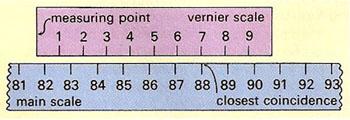vernier scale

Use of a vernier scale. The measuring point on the vernier scale is set exactly opposite the value to be measured on the main scale. The distance of the measuring point from the last scale division is then found by noting which division on the vernier scale most closely coincides with a division on the main scale. In this case, the reading is 81.7.
A vernier scale is an auxiliary scale used in conjunction with the main scale on many scientific instruments (most notably, the micrometer), allowing greater precision of reading. The vernier scale is graduated such that nine graduations on the vernier scale equal ten on the main scale. By observing which vernier graduation nearest the zero on the vernier scale coincides with a graduation on the main scale, the precision with which a reading can be made is improved by a factor of 10. It is named after the French inventor Pierre Vernier (1580–1637).


